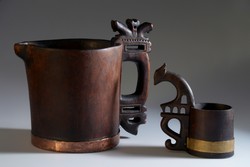Martin Mešša
The inception of the Museum of Folk Art and Craft Production in 2009 as an organic part of ÚĽUV is closely linked to the 65-years history of this cultural institution that was founded to protect and support folk art and craft production by the Presidential Decree in 1945. Already in the second year of UĽUV’s existence, in 1947, the documentation fond started to be collected. Though the museum may have differed in its direction and purpose from the common ethnographic museum collections, it did not differ in its significance. The acquisition activity concentrated on aesthetically valuable parts of folk material culture – art expression of folk people in its various forms, from simple decoration techniques to folk art. The collection was designed to preserve the typology of ornaments, decor, materials, techniques and technologies. The artefacts could be taken in hands, inspected from every angle, embroidery could be copied or one could have a copy of a mould made. The collection was steadily growing as the result of purposeful documentation field work of UĽUV’s staff that strove to capture as many as possible of the fading away phenomena of folk arts and crafts.
From the very beginning artefacts from all traditional materials were included in the collections, with folk textile being most represented. Beside complete folk costumes, there are large numbers of folk costumes´ components, laces and embroidered and woven folk textiles.
Museum has a large collection of pottery – earthenware and majolica – containing products from closed workshops and centres, but also representing contemporary production. Similarly, there are products made from wood, metal, leather, horn, basketry products, decorated eggs and paintings on glass. At present, the collection counts around fifteen thousand pieces of items.
The society’s evolution that we can see over the sixty-five years of UĽUV history calls for new forms and methods of protecting and promoting folk art and craft production. Among them is a greater use of the existing collection of patters, its systematic extension, and, in turn, its presentation to the general public.
Making the collection accessible in the form of open depository will allow permanent and wide-ranging possibilities of presenting the collection. As the result, high-quality information will be available on various forms of folk art and craft production in Slovakia for a wide spectrum of audiences interested in the folk culture.
